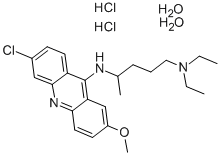Mepacrine hydrochloride manufacturers
- Mepacrine hydrochloride
-

- $0.00 / 1Kg
-
2020-04-28
- CAS:6151-30-0
- Min. Order: 1KG
- Purity: 99.0%
- Supply Ability: 500 tons
|
| | Mepacrine hydrochloride Basic information |
| Product Name: | Mepacrine hydrochloride | | Synonyms: | QUINACRINE DIHYDROCHLORIDE DIHYDRATE;QUINACRINE HYDROCHLORIDE, DIHYDRATE;6-chloro-9-((4-(diethylamino)-1-methylbutyl)amino)-2-methoxy-acridindihydr;6-chloro-9-((4-(diethylamino)-1-methylbutyl)amino)-2-methoxyacridinedihydroc;atabrinehydrochloridedihydrate;hloride2h2-o;mepacrinehcl;mepacrinehydrochloridedihydrate | | CAS: | 6151-30-0 | | MF: | C23H36Cl3N3O3 | | MW: | 508.91 | | EINECS: | | | Product Categories: | | | Mol File: | 6151-30-0.mol |  |
| | Mepacrine hydrochloride Chemical Properties |
| Melting point | 247 °C | | storage temp. | Store at -20°C | | solubility | DMSO: 10 mg/mL (19.65 mM);; | | form | Solid | | color | Light yellow to yellow | | Water Solubility | 2.8 g/100 mL | | CAS DataBase Reference | 6151-30-0(CAS DataBase Reference) |
| Provider | Language |
|
ACROS
| English |
| | Mepacrine hydrochloride Usage And Synthesis |
| Chemical Properties | bright yellow powder | | Uses | Quinacrine Dihydrochloride Dihydrate is a phophoslipase A2 inhibitor. | | General Description | Qunacrine is no longer available in theUnited States. It can be considered one of the most toxic ofthe antimalarial drugs even though, at one time, it was commonlyused. It acts at many sites within the cell includingintercalation of DNA strands, succinic dehydrogenase andmitochondrial electron transport, and cholinesterase. It maybe tumorgenic and mutagenic and has been used as a sclerosingagent. Because it is an acridine dye, quinacrine cancause yellow discoloration of the skin and urine. | | in vivo | Quinacrine (100 mg/kg three times per week for two consecutive weeks) significantly suppresses circulating blast cells at days 30/31 and increases the median survival time (MST). Quinacrine does not decrease the body weight of treated animals at the tested dose[2]. | Animal Model: | Female SCID mice with acute myeloid leukemia (AML)-PS model[2] | | Dosage: | 100 mg/kg | | Administration: | Administered by oral gavage (po); three times a week for two consecutive weeks | | Result: | In the first AML mouse in vivo study, evaluation of circulating leukemic cells detected in blood samples (in percent of white blood cells (WBC)) at day 30/31 showed 72% human tumor cells in the control mice, whereas in mice treated with Quinacrine, this was only 2.2%.
The MST of control mice was 34 days whereas it was 46 days in Quinacrine-treated mice. |
| | IC 50 | Plasmodium |
| | Mepacrine hydrochloride Preparation Products And Raw materials |
|